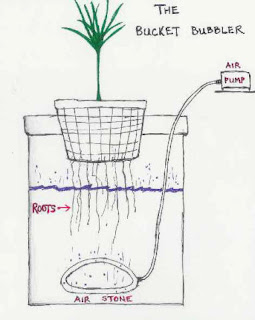Operation 420
New Member
- Joined
- Mar 26, 2011
- Messages
- 4
- Reaction score
- 0
Hi everyone! I posted this on my blog and got an excellent response. So i thought I would post it here to help anyone new to dwc and hydro. It is a very simple set up. Enjoy. 
This guide is to show how to make a simple 5 gallon bucket deep water culture system. You will need a few things, but overall it is very simple and most items can be bought at local stores.
The items you will need include:
1. 1- 5 gallon bucket - Preferably black to keep light out. If not, it's ok, you can use tape to cover the bucket if it is white or a lighter color.[3-4 dollars]
2. A net/mesh lid - Ask your local hydroponics store if they have a 6" or 10" mesh lid for 5 gallon buckets. [4-5 dollars]
3. Hydroton - You will need no more than a 10 liter bag. (If using the 6" net lid, you will have a lot leftover for other buckets) [Around 10 dollars]
4. An air pump - I suggest a 5-15 gallon pump. Go to your local pet store, or major store that has a pet department. 5-7 dollars
5. Tubing, get the tubing when you get your pump, it is very cheap. [1.50-2.50 dollars]
6. Air Stone - Get one that fits obviously. And one that gives you a lot of bubbles. [1.50-3 dollars]
Now to set it up. It is a very easy process. The below diagram will show you exactly how it works.
After you have it all set up, it is time to add your nutrients. Nutrient strength will vary depending on how old your plant is, so check your nutrient labels, or you can check our nutrient feeding schedule page at xxx.marijuana-strain-spot.com .
If you have a young plant, you want your water level to be high enough so the bubbles burst on the hydroton. If the hydroton is getting wet, the rockwool will too. Check it to make sure though.
Once your plant is bigger and the roots are longer, you can lower your water level accordingly.
Some of the biggest indoor plants I've seen were grown using a 5 gallon bucket. You will enjoy the benefits of quicker growing plants, while using less nutrients to feed them.
Well, that's it, now you now how to make a 5 gallon bucket dwc system. If this was helpful, subscribe to Strain Spot and check back, because we will be adding more guides in the future. Good luck, and happy growing!
This guide is to show how to make a simple 5 gallon bucket deep water culture system. You will need a few things, but overall it is very simple and most items can be bought at local stores.
The items you will need include:
1. 1- 5 gallon bucket - Preferably black to keep light out. If not, it's ok, you can use tape to cover the bucket if it is white or a lighter color.[3-4 dollars]
2. A net/mesh lid - Ask your local hydroponics store if they have a 6" or 10" mesh lid for 5 gallon buckets. [4-5 dollars]
3. Hydroton - You will need no more than a 10 liter bag. (If using the 6" net lid, you will have a lot leftover for other buckets) [Around 10 dollars]
4. An air pump - I suggest a 5-15 gallon pump. Go to your local pet store, or major store that has a pet department. 5-7 dollars
5. Tubing, get the tubing when you get your pump, it is very cheap. [1.50-2.50 dollars]
6. Air Stone - Get one that fits obviously. And one that gives you a lot of bubbles. [1.50-3 dollars]
Now to set it up. It is a very easy process. The below diagram will show you exactly how it works.
After you have it all set up, it is time to add your nutrients. Nutrient strength will vary depending on how old your plant is, so check your nutrient labels, or you can check our nutrient feeding schedule page at xxx.marijuana-strain-spot.com .
If you have a young plant, you want your water level to be high enough so the bubbles burst on the hydroton. If the hydroton is getting wet, the rockwool will too. Check it to make sure though.
Once your plant is bigger and the roots are longer, you can lower your water level accordingly.
Some of the biggest indoor plants I've seen were grown using a 5 gallon bucket. You will enjoy the benefits of quicker growing plants, while using less nutrients to feed them.
Well, that's it, now you now how to make a 5 gallon bucket dwc system. If this was helpful, subscribe to Strain Spot and check back, because we will be adding more guides in the future. Good luck, and happy growing!






